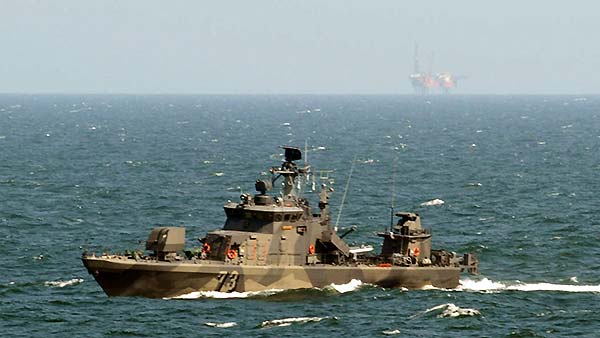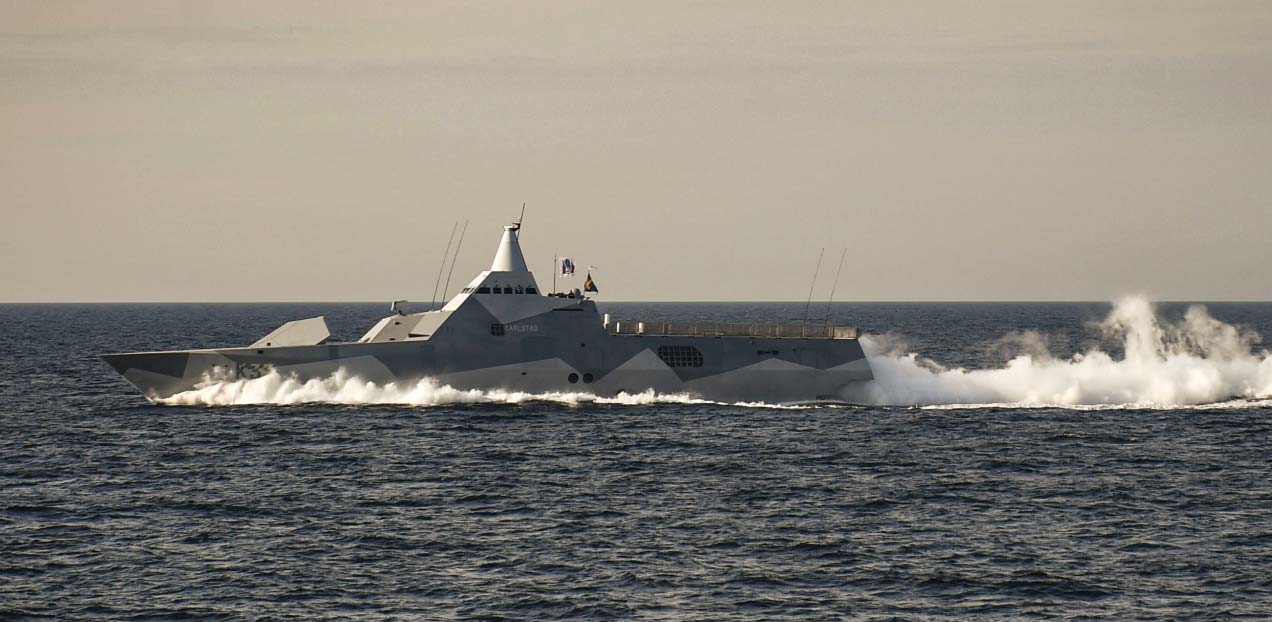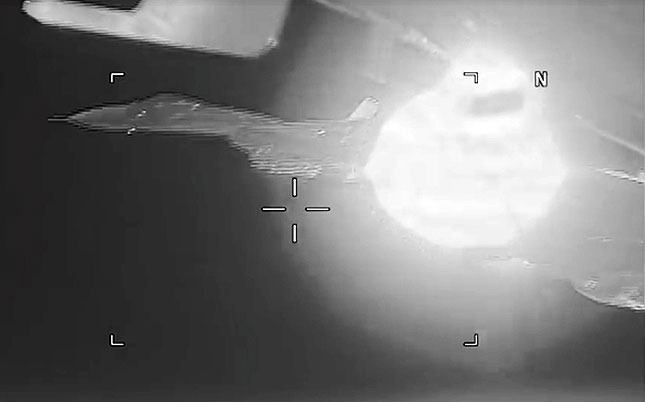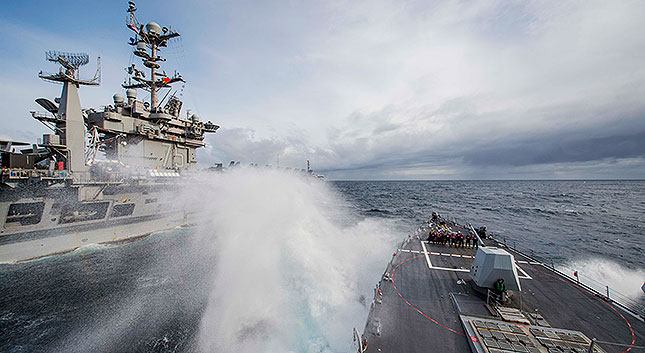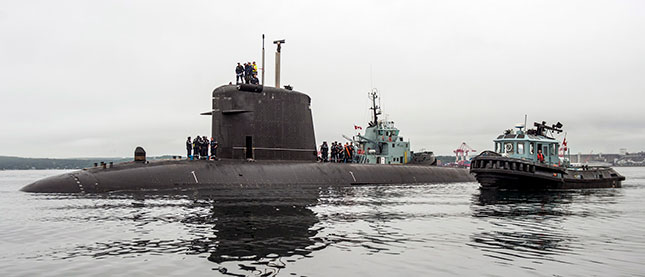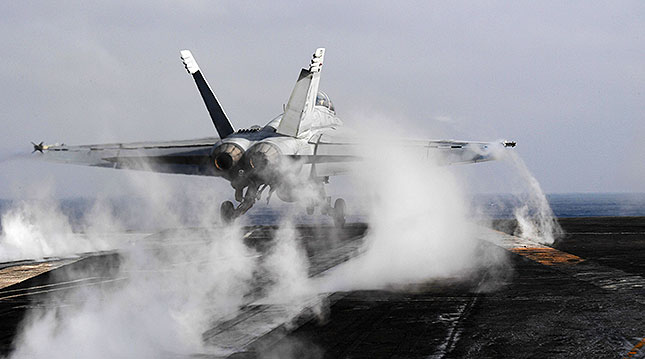Iain Ballantyne, author of ‘The Deadly Trade: The Complete History of Submarine Warfare from Archimedes to the Present’, concludes a two-part look at the contours of a fast evolving new undersea confrontation. Iain is talking about the history of submarine warfare during this year’s Isle of Wight Literary Festival and will touch on some of the topics outlined below.
The bad old days are back. Just as happened during the Cold War face-off, today the Russian Bear and the West are snarling at each other in a war of words while their militaries train relentlessly for the day it all turns red hot. They hope that by being ready for combat they will deter the other side from launching an attack, though there is no capitalism versus communism ideological struggle underpinning it this time.
Pumped up, ultra-muscular nationalism allied with a desire to maintain superpower status and control scarce natural resources to shore up a tottering economy seems to drive Russia. It also nurtures massive resentment towards the West for not respecting it enough post-1991 and is intensely hostile towards EU and NATO expansion into its ‘near abroad’.
In the West, there is bewilderment at how things could suddenly get so serious again, with reluctance to invest in hard power tools in a time of economic and political turbulence.
There has been a nerve agent assassination plot committed on a NATO member state’s soil by Russian military intelligence agents. A series of cyber attacks on commerce, industry and national infrastructure along with alleged interference in the political process are also suspected of being staged by Russia. There is a temptation to see this as the most vital East-West battleground – a conflict in which cyber weapons and the occasional foray by not-so-secret agents are the main weapons deployed by Russia. In reality it is all running in parallel with the flexing – and even use – of hard power military muscle by the Kremlin, including submarines.

The newly upgraded Oscar II Class guided-missile submarine Orel returning to her Northern Fleet base in the Kola Peninsula. Photo: Russian defence ministry.
With Moscow’s submarines now at their most active since the end of the Cold War, President Vladimir Putin has authorised construction of up to a dozen Yasen Class, nuclear-powered attack submarines. An expansion of Russia’s conventionally powered submarine force is well underway too. The new Improved Kilo Class boats are cruise missile capable, with some having already launched attacks against rebel targets in Syria (to shore up the Damascus regime). The older, nuclear-powered Oscar II Class – so called carrier-killing guided-missile boats (SSGNs) – are also being regenerated with new weaponry. They will form a serious threat to Western naval forces.
NATO has responded by proposing establishment of an Atlantic Command to operate in times of crisis to counter surges in Russian naval activity. The precursor to this has been reactivation of the US Navy’s 2nd Fleet organisation to take overall charge of co-ordinating efforts from the North Atlantic down to the Caribbean. In recent years there has been an upsurge in NATO Anti-submarine Warfare (ASW) exercises, from the Mediterranean to the Arctic. The Russians have responded by staging their own ASW training in the same operational theatres, most recently as part of the huge time zone-spanning Vostok-18 exercise.
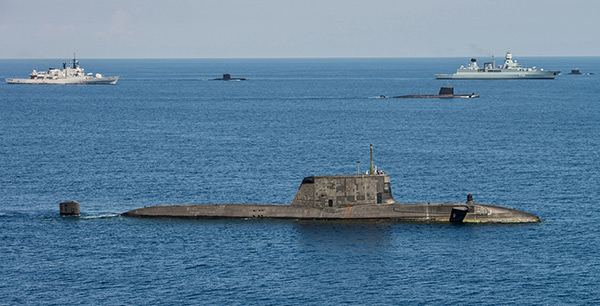
The Astute Class attack submarine HMS Ambush (nearest) during an ASW exercise in the Mediterranean with other NATO units. Photo: WO Artigues (HQ MARCOM)/NATO.
Beyond such play-acting, serious though it is, there have been episodes where units from both sides of this so-called new Cold War have been engaged in hunting each other. Russian submarines have trailed a Franco-American carrier strike group in the Mediterranean while Moscow’s anti-submarine vessels pursued a Dutch diesel boat seeking to gather intelligence on the Russian Navy’s own aircraft carrier operating off Syria. A US Navy attack submarine has allegedly engaged in trailing Russian surface warships in the Med. In more northern waters the Finns, Swedes, Norwegians and Balts have responded to suspected submarine intrusions (and in the case of the Finns even using depth charges).
Aside from those shadow games, the bombardment of Assad regime chemical warfare sites in Syria this April saw a nuclear-powered submarine launching cruise missiles from somewhere in the eastern Mediterranean. It was not a British boat, but the USS John Warner, one of the USN’s Virginia Class SSNs. There were reports in the media of Royal Navy submarines also being on standby to participate in the attacks. In the end, so it was claimed, rather than launch cruise missiles, an Astute Class boat was engaged in an undersea game of cat and mouse with two Russian Navy Improved Kilo Class submarines deployed from Tartus, Moscow’s main naval facility in Syria.
However, there are also doubts an Astute Class SSN was there at all – due to a lack of availability in the UK’s SSN force. Yet in the current war of nerves between the Russia and the West, which takes so many different forms, just the thought of a British, or American, SSN lurking in the eastern Mediterranean was surely a powerful inhibitor on the Russians? A Kilo might be super-stealthy at slow speed on battery power, but nothing beats the sheer speed and hitting power of SSN. The mere suspicion of one being nearby would make a Kilo captain very cautious.
The Russians have, meanwhile, described Britain’s new super-carrier HMS Queen Elizabeth – which this autumn made her maiden transatlantic voyage to welcome aboard her first F-35B strike jets – as ‘just a convenient, large maritime target’. Russia undoubtedly has every intention of sending out submarines to find and trail Queen Elizabeth, in order to gain intelligence on the carrier’s performance that may help sink her, should it ever come to hot war.
Resuscitating the NATO ASW effort is no small task. Rear Admiral Roger Lane-Nott, a former RN Flag Officer Submarines (FOSM), warned at the end of last year: ‘The chilling fact is that the organisations, relationships, intelligence, and capabilities that once supported a strong ASW network for NATO in the North Atlantic no longer exist.’
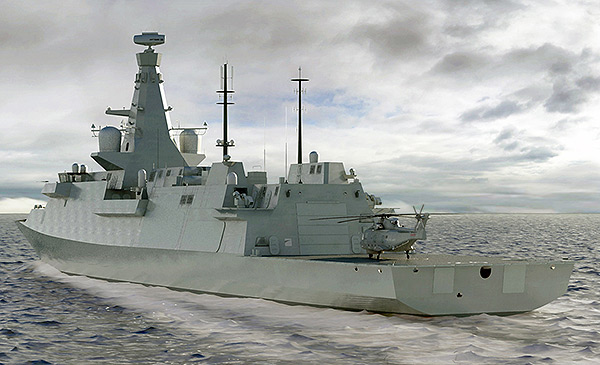
An exterior view depiction (from astern) of the forthcoming City Class (Type 26) frigate (or Global Combat Ship as the design is officially known). Image: BAE Systems.
The commitment to building eight new generation City Class (Type 26) ASW frigates is, however, a major investment UK national security and will be big boost to NATO defences. They are to be base ported at Devonport, the traditional home of the RN’s ASW primary surface warships. Three Type 26s have been ordered at the time of writing, to be named Glasgow, Cardiff and Belfast, with another to be christened Birmingham.
There have also been cash injections into programmes to build new Dreadnought Class ballistic missile submarines (SSBNs) and to ensure a seventh Astute Class SSN (to be christened Agincourt) is constructed. The arrival of the first of nine new P-8 Poseidon Maritime Patrol Aircraft (MPAs) for the RAF in 2019 is another welcome sign of long overdue revival.
There have even been encouraging indicators the British political leadership is finally awake to the new struggle for the freedom of the oceans – and the need for strong ripostes. UK Secretary of State for Defence Gavin Williamson in late May gave the inaugural Sir Henry Leach lecture during the RUSI Sea Power conference in London.
He pointed out that Russia’s submarine activity has “increased ten-fold in the North Atlantic.” Mr Williamson went on: “But that’s not all. In 2010, the Royal Navy had to respond once to a Russian Navy ship approaching UK territorial waters. Last year we had to respond 33 times. It goes to show the increasing aggression, the increasing assertiveness of Russia, and how we have to ensure we give the right support to our Royal Navy in order to give them [sic] the tools to do the job and keep Britain safe.”
Whether or not the Royal Navy is getting enough of the tools – and quickly enough – to do the job is open to debate. Were the UK sticking to a North Atlantic orientated maritime defence strategy, then seven Astutes, eight Type 26s, six Type 45 destroyers, nine P-8s and two new super-carriers (the cutting edge of the New Navy) would be just about enough to cope – but British strategic over-reach looks likely to be layered on top of existing overstretch, with simultaneous major long-term commitments to the Arabian Gulf and also patrolling the South China Sea.
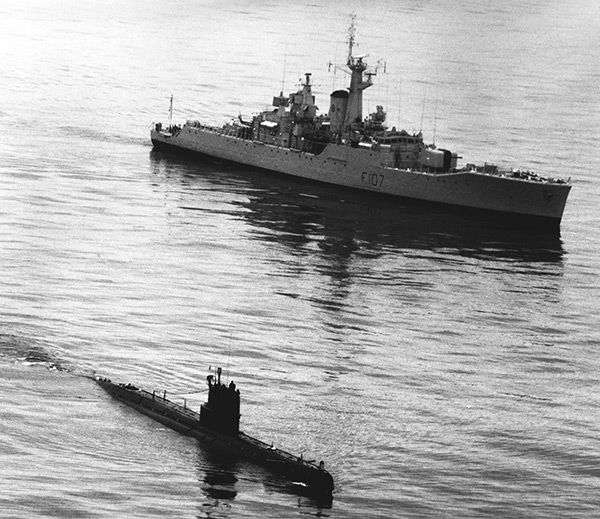
During the Cold War a Soviet Navy submarine of the Whiskey Class is escorted out of NATO waters by the British frigate HMS Rothesay. Photo: Via US DoD.
Back in the late 1960s the British gave up enduring commitments – and shore bases – east of Suez at a time when they had dozens more frigates and destroyers, several aircraft carriers and dozens of nuclear and conventional submarines, with around 20,000 sailors at sea. Today the Royal Navy is so short of sailors it is selling off warships or putting them into mothballs so their people can be sent elsewhere.
The Royal Navy is redefining the concept of spreading the jam very thinly but it gamely battles on, retaining a reputation for excellence and playing in the big league in those niche areas. It must be hoped the gaps it its sovereign capabilities are not one day exploited ruthlessly by a merciless opponent (like Russia).
The challenge The Royal Navy is facing today – and for decades to come – is clearly formidable, especially in the realm of ASW, with the current head of US Navy forces in Europe, Admiral James Foggo warning in a podcast this month (October): “Russia has renewed its capabilities in the North Atlantic and the Arctic in places not seen since the Cold War.”
The admiral also warned that Russia is seeking to “project power” not only into the Arctic but also the North Atlantic and Greenland Iceland UK Gap (GIUK) – Britain’s back yard. Foggo did not hide the nature of the undersea threat: “I think Russian submarines today are perhaps some of the most silent and lethal in the world,” he said, though adding that the US Navy’s own “hold the edge.”
The admiral also explained that Moscow is tasking its submarine forces with finding weak points in NATO’s armour. “We know that Russian submarines are in the Atlantic, testing our defences,” said Admiral Foggo. He suggested the Russians are “preparing a very complex underwater battlespace to try to give them an edge in any future conflict. And we need to deny them that edge.”
Admiral Foggo believes Russian “actions and capabilities [have] increased in alarming and sometimes confrontational ways”. Moscow is laying down the gauntlet to both the USA and NATO, which inevitably includes the UK.
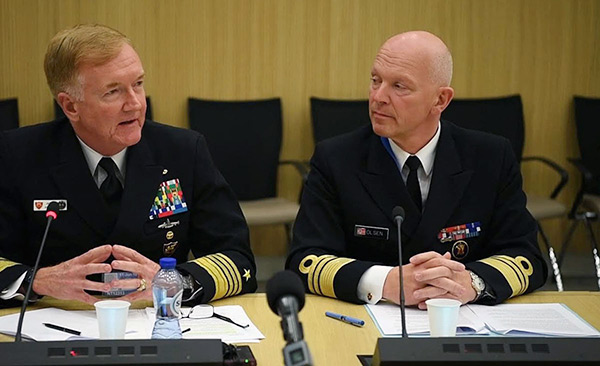
Admiral James G. Foggo during a meeting with Admiral Ketil Olsen, Military Representative of Norway to the NATO Military Committee. Photo: NATO.
Its Trident nuclear missile submarines have been subjected to attempts by Russian SSNs to find and trail them, so negating the deterrent’s chief effect – the ability to deter a potential enemy by hiding in the sea and being ready to strike with devastating force at any moment.
Admiral Foggo remains “concerned about the potential for miscalculation” and suggests NATO cohesion is key to handling the risks. That has to include seeking a decisive edge in both submarine warfare and ASW, with British naval forces compelled to be at the fore, for reasons of geography if nothing else.
• This is an adapted and updated version of an article that was published in The Association of Royal Navy Officers Newsletter (Summer 2018)
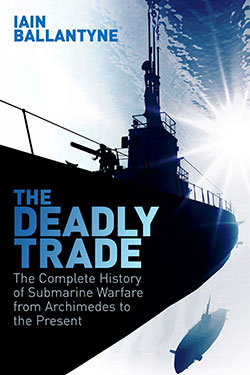
Recent episodes in the new East-West naval rivalry and action-packed aspects of submarine warfare across the ages are recounted in Iain Ballantyne’s new book ‘The Deadly Trade: The Complete History of Submarine Warfare from Archimedes to the Present’, published by Weidenfeld & Nicolson (752 pages, hardback £25.00/eBook £12.99). More details here. It is available via Amazon and Waterstones or other retailers and shops.
Iain Ballantyne is also founding and current Editor of WARSHIPS International Fleet Review magazine, www.warshipsifr.com which in 2018 celebrated its 20th birthday.


